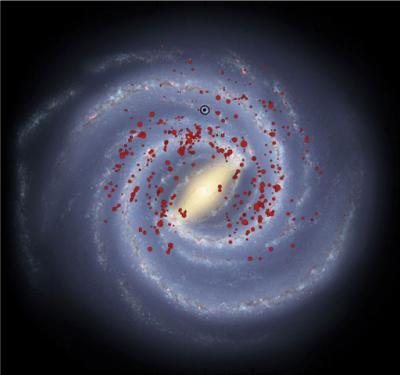It's not well known but astronomers actually cannot see what our Galaxy, the Milky Way, really looks like. We are on the inside looking out so scientists instead deduce its shape by observation of its stars and their distances from us.
In the 1950s, astronomers used radio telescopes to map our Galaxy. Their observations focused on clouds of gas in the Milky Way in which new stars are born, revealing four major arms. More recently, NASA's Spitzer Space Telescope scoured the Galaxy for infrared light emitted by stars but in 2008 it was announced that Spitzer imaging had found about 110 million stars, yet only evidence of two spirals. Did the Milky Way have missing arms? Were they ever there?
A 12-year study of massive stars finds that our Galaxy does have four spiral arms rather than two.

The distribution of massive stars in the new study. Our location within the Galaxy is circled in black. Credit: J. Urquhart et al. Background image by Robert Hurt of the Spitzer Science Center.
The astronomers behind the new study used several radio telescopes in Australia, USA and China to individually observe about 1650 massive stars that had been identified by the RMS Survey. From their observations, the distances and luminosities of the massive stars were calculated, revealing a distribution across four spiral arms.
Massive stars are much less common than their lower mass counterparts because they only live for a short time – about 10 million years. The shorter lifetimes of massive stars means that they are only found in the arms in which they formed, which could explain the discrepancy in the number of galactic arms that different research teams have claimed.
"Lower mass stars live much longer than massive stars and rotate around our Galaxy many times, spreading out in the disc. The gravitational pull in the two stellar arms that Spitzer revealed is enough to pile up the majority of stars in those arms, but not in the other two," explains Professor Melvin Hoare, a member of the RMS Survey Team in the School of Physics&Astronomy at the University of Leeds and a co-author of the research paper. "However, the gas is compressed enough in all four arms to lead to massive star formation."
Dr. James Urquhart from the Max Planck Institute for Radio Astronomy in Bonn, Germany, and lead author of the paper, said, "It's exciting that we are able to use the distribution of young massive stars to probe the structure of the Milky Way and match the most intense region of star formation with a model with four spiral arms."
Professor Hoare concludes, "Star formation researchers, like me, grew up with the idea that our Galaxy has four spiral arms. It's great that we have been able to reaffirm that picture."
Source: University of Leeds





Comments